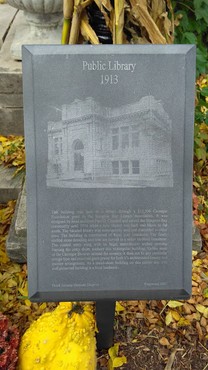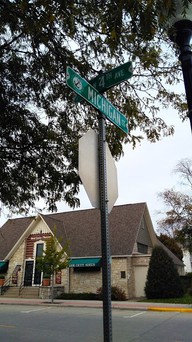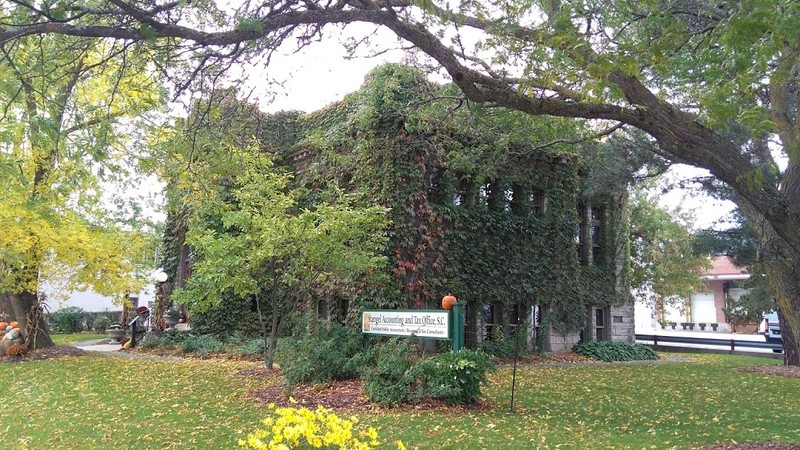Carnegie Free Library (Sturgeon Bay)
Introduction
Text-to-speech Audio
Images
This marker, placed outside the Carnegie Free Library building, provides an overview of its history and significance.

Once Spruce Street and Court Street, the Carnegie Free Library now sits at the intersection of 4th Avenue and Michigan Street.

Once fairly bare, the Carnegie Free Library site and building are now verdant with trees and ivy.

The Carnegie Free Library building is home to Stangel Accounting and Tax Offices, S.C.

Backstory and Context
Text-to-speech Audio
Public library service in the state of Wisconsin officially began in 1872, when state legislation was enacted "permitting the establishment of public libraries."(1) Yet although Sturgeon Bay’s Library Association was formed in 1866 – six years before the official advent of public library service in Wisconsin – Sturgeon Bay was one of the last three Wisconsin cities with a population greater than 3,000 to be without a formal public library. Funding was secured from the Carnegie Foundation in 1911, and the Carnegie Free Library opened to the public in 1913. The path to that library, as recounted in the newspaper articles celebrating its founding, was one marked by determination and resilience.
Early Library Efforts
Between 1866 and 1872, the Sturgeon Bay Library Association conducted weekly meetings at the old courthouse in Sturgeon Bay. Open to the public, these meetings included readings of prose, poetry recitations, and debates on vital contemporary issues, including women’s suffrage (the general consensus: women should have the right to vote). During this time period, the Library Association amassed a collection of about 500 books and documents, including Blue Books and patent office reports. Although attendance at Library Association meetings was initially high, interest waned in the 1870s. By 1880, the meetings had all but stopped, and the Association’s collection was stored "at various places, especially attorney offices."(2)
Despite this waning interest, the desire to have a library in Sturgeon Bay was still strong. In 1892, the Library Association's collection moved to the telephone exchange office in a building owned by Mr. Washburn, where – presided over by de facto librarian Mrs. Sybil (Minor) Elwell – the library operated for five years. When the exchange service was discontinued in 1897, the exchange office closed, and the Library Association divided the library collection between the attic of Mr. Washburn’s neighboring feed store and the high school building. There the collection remained, until a new association took up the cause.
In early 1901, twenty-seven local women formed the Women’s Association. One of their core purposes, decided at the association’s inception, was "the establishing of a reading and lunch room."(3) The association appointed Lillian Nelson as the acting librarian, and between April and August of 1901 the reading and lunch room operated out of what had once been the McNeeley harness shop. When the short-lived reading room closed due to a lack of human resources, Women’s Association member Mrs. Kirtland took charge of the library books, which she housed above her store. A setback occurred in July 1903, when many of the library’s older materials – which had been moved to "one of the rooms in the old school house"(4) – burned down with the building.
In 1904-1905 (sources vary), the books were moved from Kirtland’s store to the store of E. M. LaPlant, and the city began allocating $100 a year "for the maintenance of the library’s housing and collection."(5) In 1906, the Women’s Association officially turned the collection over to the city; the city then formed an official Library Board, and in September of 1906, the bulk of the library’s collection was moved into the "Pinney building"(6): a large retail building at 11 N. 3rd Avenue, purchased that year by the editor of the Door County Democrat, J. J. Pinney. The collection would remain at the Pinney building until 1913, under the supervision of librarian Eva Greisen until 1909 and after, librarian Grace Lown.
Negotiating with Carnegie
In 1902, Mrs. Y.V. Dreutzer of the Women’s Association "began communicating with Mr. Carnegie’s secretary setting forth the need of a library in [the] city."(7) The city took over her efforts the following year, and began almost a decade of negotiating for a library in Sturgeon Bay. Because Sturgeon Bay at the time had fewer than 5,000 residents, the city’s original request for $15,000 had been rejected. Instead, the Foundation had agreed to provide a $12,500 grant, if the Board would accept two provisos: one, that the city provide "a suitable site"(8) for the new Carnegie library, and two, that the city guarantee $1,250 be set aside each year for the maintenance of the library. This "requisite 10 per cent [sic]"(9) had been a stipulation of the Foundation’s since 1903, and proponents of the library had continually fought to justify the amount to the city council. On May 2nd, 1911, the Library Board’s negotiations with the Carnegie Foundation finally came to a close when the city agreed to meet the Foundation’s terms.
The site selected for the library, at the intersection of what were then Spruce and Court Streets, was "in the [geographical] center of the city."(10) Soon after the Carnegie Foundation and Library Board reached their agreement, the Board began the search for an architect and builders. Three sets of architects submitted proposals for the new library: Foeller and Schubert of Green Bay, Claude and Starck of Madison, and Fred D. Crandall of Sturgeon Bay. Crandall had also designed the Pinney building, and on August 23rd, 1911, the Board accepted his plan for the new library. Fred Wulf and John Gabert were soon chosen as the builders, and for almost two years, the library was under construction.
The Carnegie Free Library
Crandall’s design used a Classical Revival/Neoclassical style popular in Sturgeon Bay. The finished library – constructed from local limestone and Bedford stone – had an open first-floor plan with a reading room, reference room, centrally-located "librarian’s room,"(11) and a children’s room with a tile fireplace. To enter the library, users would climb an oak staircase and enter the vestibule, which featured a “mosaic tile floor with a Greek key pattern and the word ‘Library’ in the center."(12) In preparation for the opening of the new library, 1,300 new materials were added to the collection.
On Thursday, May 1st, 1913, the city held a well-attended dedication ceremony for the library. One of the Library Board members in attendance, Mrs. C. B. Packard, had been a founding member of the Women’s Association in 1901. At the dedication, M.S. Dudgeon, Secretary of the Wisconsin State Library Commission, lauded Crandall’s design as "one of the finest in the state."(13) District Attorney H. Graass presented a history of the public library in Sturgeon Bay and expressed gratitude to "the loyal ladies of this city, to whose thotful [sic] care and energy and stick-to-it-ive-ness we are indebted for this beautiful structure."(14) In its coverage of the event, the Door County Democrat reported that an estimated 2,318 patrons had borrowed books from the Pinney building between 1907 and 1912, and the library’s collection had grown to number 3,000 books. On Saturday, May 3rd, 1913, the Carnegie Free Library of Sturgeon Bay officially opened to the public.
Closure and Repurposing
In 1974, the Door County Library of Sturgeon Bay was built, and the Carnegie Free Library closed its doors. On December 29th, 1988, the Carnegie Free Library of Sturgeon Bay was added to the National Register of Historic Places; on New Year’s Day, 1989, it became a part of the Wisconsin State Register of Historic Places as well. Currently, the building is owned by local businessperson Vicki Stangel, and since 2004, the Carnegie Free Library building has been home to Stangel Accounting and Tax Offices, S.C.
Sources
DeRose, Joe. "11 N 3RD AVE," Architecture and History Inventory. The Wisconsin Historical Society. Accessed December 5 2019. https://www.wisconsinhistory.org/Records/Property/HI49700
DeRose, Joe. "354 MICHIGAN ST," Architecture and History Inventory. The Wisconsin Historical Society. Accessed December 5 2019. https://www.wisconsinhistory.org/Records/Property/HI50197
Veregin, Peggy. "354 Michigan St," National or State Register of Historic Places. The Wisconsin Historical Society. Accessed December 5 2019. https://www.wisconsinhistory.org/Records/NationalRegister/NR1926.
"Carnegie's Gifts $142,500." Racine Journal (Racine, WI). October 20, 1903, p.11. Accessed December 5 2019. https://newspaperarchive.com/
"Stangel Accounting & Tax Ofc," U.S. Businesses. ReferenceUSA. Accessed December 5 2019. https://referenceusa.com/
"Library Established Here in 1897." Rhinelander Daily News (Rhinelander, WI). April 14, 1973, p.2. Accessed December 2 2019. https://newspaperarchive.com/
"Open Carnegie Library." Sturgeon Bay Advocate (Sturgeon Bay, WI). May 8, 1913, Vol. 52 No. 7 p.3. Accessed November 21 2019. https://newspaperarchive.com/
"The Carnegie Library." Sturgeon Bay Advocate (Sturgeon Bay, WI). August 24, 1911, p.5. Accessed November 21 2019. https://newspaperarchive.com/
"Carnegie Will Give $12,500." Sturgeon Bay Advocate (Sturgeon Bay, WI). May 4, 1911, p.1. Accessed December 5 2019. https://newspaperarchive.com/
"Local News." Sturgeon Bay Advocate (Sturgeon Bay, WI). March 14, 1903, p.5. Accessed December 5 2019. https://newspaperarchive.com/
"Opening of New Carnegie Public Library." Sturgeon Bay Door County Democrat (Sturgeon Bay, WI). May 2, 1913, Vol. 21 p.4. Accessed November 21 2019. https://newspaperarchive.com/
Footnotes
(1) "Library Established Here in 1897." Rhinelander Daily News (Rhinelander, WI). April 14, 1973.
(2) "Open Carnegie Library." Sturgeon Bay Advocate (Sturgeon Bay, WI). May 8, 1913.
(3) "Opening of New Carnegie Public Library." Sturgeon Bay Door County Democrat (Sturgeon Bay, WI). May 2, 1913.
(4) "Open Carnegie Library." Sturgeon Bay Advocate (Sturgeon Bay, WI). May 8, 1913.
(5) "Opening of New Carnegie Public Library." Sturgeon Bay Door County Democrat (Sturgeon Bay, WI). May 2, 1913.
(6) Ibid.
(7) "Open Carnegie Library." Sturgeon Bay Advocate (Sturgeon Bay, WI). May 8, 1913.
(8) "Carnegie Will Give $12,500." Sturgeon Bay Advocate (Sturgeon Bay, WI). May 4, 1911.
(9) "Local News." Sturgeon Bay Advocate (Sturgeon Bay, WI). March 14, 1903.
(10) "Opening of New Carnegie Public Library." Sturgeon Bay Door County Democrat (Sturgeon Bay, WI). May 2, 1913.
(11) Ibid.
(12) Veregin, Peggy. "354 Michigan St," National or State Register of Historic Places. The Wisconsin Historical Society.
(13) "Open Carnegie Library." Sturgeon Bay Advocate (Sturgeon Bay, WI). May 8, 1913.
(14) Ibid.
Author's photograph, taken October 12 2019.
Author's photograph, taken October 12 2019.
Author's photograph, taken October 12 2019.
Author's photograph, taken October 12 2019.
